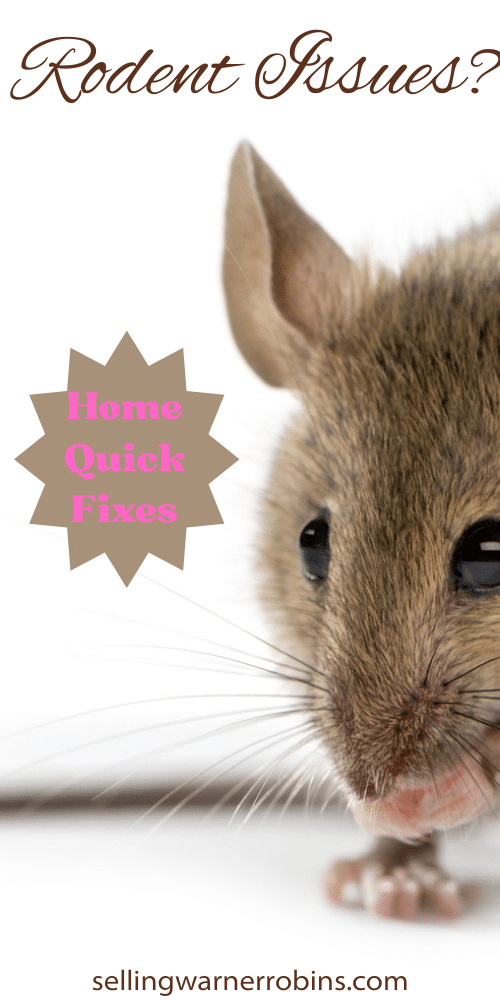Homebuyers Quick Fix: Fast Solutions for Rodent Problems
Rodent infestations are definitely a problem to worry about but with a little knowledge the solutions for rodent problems identified in this article will help you rid your property of these pests!
Rodents are a serious issue to both health and property. Among the most common culprits are the house mouse and various species of rats. House mice are typically small and grayish-brown, ranging from two to seven inches in length, and are notorious for their ability to cause damage by gnawing on wires and constructing nests within walls and other concealed spaces.
They also carry health risks, as they can contaminate food sources and spread diseases like Salmonella. House mice can squeeze through openings as small as a dime due to their agility. Their rapid reproductive cycle makes them capable of producing multiple litters per year.

The Uninvited Houseguest: Understanding Rodent Problems
Norway rats, larger in size and typically brown or gray, are known for their particularly destructive nature, capable of gnawing through a wide array of materials, including wood, insulation, and even some metals. This behavior not only causes structural damage but also increases the risk of electrical fires.
Roof rats, often found in higher elevations within a home, such as attics, are smaller than Norway rats and are adept climbers, frequently using trees and gardens as pathways. Like other rodents, they can also damage property and spread diseases such as Salmonella and typhus.
Deer mice, prevalent throughout North America, are generally found in rural areas but can venture indoors, particularly during colder months, and are significant carriers of Hantavirus. Indirectly transmitted diseases include the Plague, Lyme disease, Murine Typhus, and Rickettsial pox.
Rodent infestations are not merely a nuisance; they pose significant health hazards and can cause substantial property damage. These diseases can be transmitted to humans directly through handling, bites, or contact with their droppings, urine, and saliva, or indirectly through vectors like ticks, mites, and fleas that feed on infected rodents. Contamination of food and water sources with rodent waste can lead to various illnesses. Their contact can also trigger allergies.
Their activity can lead to damaged insulation, destroy air ducts, and potentially spread allergens throughout the ventilation system. In some cases, rodents may even cause damage to your crops. Therefore, it requires active addressing.
Rodents are easier to control before they become well-established in a home. Their ability to multiply quickly means that early detection and intervention are key to preventing extensive damage and health risks. A short delay can result in a much larger infestation and a greater potential for health and property consequences.
While initial DIY efforts might give you temporary relief, they often fail to eradicate the infestation completely, requiring professional help. Check out these effective long-term solutions for rodent problems.
Your First Line of Defense: Traditional Rodent Control Solutions
Sealing potential entry points is a fundamental step in preventing rodents from accessing a home. Mice, with their small size, can squeeze through openings. Rats can also enter through gaps as small as 1/2 inch or holes the size of a quarter. A thorough inspection both inside and outside the home is necessary to identify all possible access points.
Inside, common entry points include areas behind kitchen cabinets, inside and under closets, around fireplaces, windows, doors, behind appliances, around pipes under sinks, and leading to water heaters and furnaces. Floor areas in corners, around floor air and dryer vents, and along all electrical, water, gas, and sewer lines should also be checked, as well as attics, basements, crawl spaces, floor drains, and the juncture between the floor and wall.
Outside, potential entry points can be found in the roof among the rafters, gables, eaves, and soffits, around windows and doors, between the foundation of the home and the ground, around the attic, crawl space vents, and around holes for electrical, plumbing, cable, and gas lines.
Once identified, these gaps and holes should be sealed to prevent rodent entry. Small holes can be effectively filled with steel wool, which rodents cannot easily chew through. Then, seal it in place with caulk or spray foam.
For larger openings, materials like lath screen or metal, cement, hardware cloth, or metal sheeting can be cut to size and used to create a physical barrier.
When you start living in your home, the foundation can develop cracks that rodents can exploit. It is, therefore, important to make regular inspections. In older houses, such as those found in Boston, specific areas might require extra attention. The foundation of homes made with stone might have more gaps that need to be filled. Basements and crawl spaces are also more prevalent in older homes. It can be an invitation for rodents.
In earthquake-prone regions like San Francisco, sealing rodent entry points requires consideration of the area-specific challenges. Specific housing types and environmental conditions, such as older foundations in Boston and earthquake concerns in San Francisco, highlight that a tailored approach is more effective than a generic one.
It is also important to keep in mind that rodents are attracted to readily available food and water. So, all food, including pantry staples, leftovers, and pet food, should be stored in sealed containers. As well as spilled food should be cleaned up immediately, and dishes and cooking utensils should be washed soon after use.
If you own a pet, pet food should be put away after feeding times, and water bowls should not be left out overnight. Inside, keep the garbage concealed and should be disposed of regularly. Outdoor, if you own a grill, keep it clean. Similarly, the compost bin should be at least 100 feet away from the house. If you own a fruit tree or have a kitchen garden, clean the leaves, rotten fruits, and harvest them as they ripen.
In densely populated environments like the one in NYC apartments, the importance of proper food storage is necessary. Remove clutter and debris from all areas of the property to not give a nesting ground to rodents. The shared apartments can risk the spreading of infestation between units. It becomes important that there are coordinated efforts and communication among residents.
Innovation to the Rescue: Less Discussed Rodent Control Methods
Beyond traditional methods, innovative solutions are emerging to address rodent problems more effectively and sustainably. Smart traps represent an advancement in rodent control technology, utilizing sensors for real-time monitoring and often focusing on humane capture.
The growth in technology also prioritizes humane, no-kill capture, allowing homeowners to release the rodents in a safe location away from their homes. These are more sophisticated and user-friendly rodent control options.
With environmental awareness, there is a rise in demand for eco-friendly rodenticides. These products contain organic components and natural ingredients to control rodent populations in a more sustainable manner. There are products available that are made from all-natural ingredients that are safe for children, pets, and wildlife, even if ingested.
Artificial intelligence (AI) and machine learning are also taking pest infestation control to the next level. It helps in the development of precision pest control strategies by analyzing extensive data related to pest behavior, environmental conditions, and historical infestation patterns.
This integration of AI with monitoring devices can help with real-time insights into rodent activity. The development of autonomous AI-powered robotic systems gives us hope for a future with highly efficient pest control services.
A Holistic Approach: Integrated Pest Management (IPM)
IPM is a comprehensive and sustainable approach to rodent control. It combines various processes like exclusion, sanitation, and biological control to prevent future infestations. IPM focuses on preventing pest problems by working on the root cause of the rodent problem. 
It also includes integrating multiple methods, regular inspection, monitoring, and tailored methods to tackle the problem. Sanitation plays a crucial role in IPM. It starts by removing sources of food, water, and harborage that rodents rely on. Next comes physically sealing all potential entry points to prevent rodents from accessing the home.
IPM also encourages natural predators of rodents, such as owls and raptors, to help manage their populations. The goal of IPM is long-term and economical solutions to rodent problems. IPM also includes community enlightenment about the solution, causes, and impact.
IPM emphasizes using the safest and most effective methods. This multi-faceted approach of IPM, combining prevention, non-chemical methods, and targeted pesticide use, is more sustainable than relying on any single method.
While you can work on some minor rodent issues by yourself, a severe or persistent infestation makes it necessary to call a professional pest control service. It often comes with multiple benefits like their specialized knowledge, customized treatment plans, use of safe and effective treatment options, and focus on long-term solutions.
Professionals are also more likely to identify all types of pests present, not just the most obvious ones. They can provide valuable advice on preventative measures and effectively seal off entry points to ensure rodents do not return.
DIY methods and home remedies might give you results, but they will have a short-term impact. You should choose a company that offers Integrated Pest Management (IPM) services.
For example, a large city like Atlanta is naturally conducive to rodent populations. Atlanta’s mild winters are best for rodents’ reproduction all year long. The humid subtropical climate also creates an abundance of vegetation that provides both food sources and nesting materials for rodents.
And the hot, humid Georgia summer is a clear invitation for rodents to seek refuge in your cool homes. This regional climate of Georgia makes professional pest control services with local expertise even more valuable. They understand how these climate factors influence rodent behavior patterns throughout the different seasons. They are familiar with common housing construction styles, such as homes with crawl spaces, which can be particularly vulnerable to rodent entry.
They can also conduct thorough inspections to identify all entry points and develop targeted treatment plans that are effective for the specific situation of your home and tailored advice on long-term prevention strategies suitable for the region.
Staying One Step Ahead: Proactive Rodent Prevention Measures
You cannot remove rodents once and wish things stayed the same forever. Unfortunately, it does not work like that but these solutions for rodent problems can help you keep them at bay. Pest infestation requires routine inspections and regular checkups for any signs of potential rodent activity. One of the most common indicators of rodent presence is their droppings. It can be found near the food storage area, in drawers and cupboards, and/or under the sink. solutions for rodent problems
Here, you must also know the difference between mouse and rat droppings. Mouse droppings are small with pointed ends, while rat droppings are larger and have blunt ends. Other signs of rodent activity are gnaw marks on furniture, baseboards, electrical wires, and food packaging. You should also see areas of nesting like shredded paper, fabrics, or insulation that is hidden from your eyes.
You can also hear some scratching noises coming from inside walls or ceilings if there are rodents in your house. Rodents also bring a musty or stale odor with them. Look for oily residue trails along the walls or furniture, holes chewed through walls and floors, and the presence of rat burrows near garbage cans or compost piles.
If your house or area is more prone to infestation, it is recommended that you do a monthly checkup of the following areas: gaps around pipes, vents, utility lines, windows and doors, attics, basements, and crawl spaces. The key is to check less obvious places where rodents are likely to hide.
Your community or the locality you live in also plays an important role in pest control, especially if you live where houses are in close proximity or in densely populated areas. Rodents can often jump from one area to another. Making a coordinated effort at the neighborhood level becomes essential since it stretches beyond your individual boundaries.
The residents in your area should ensure there is proper waste management. Any piled-up garbage is an invitation to rodents. There should be easy access to trash containers, and all the lawns should be mowed regularly.
Another important point to note is that you should check for any cracks or holes in the building or the sidewalk. Initiatives like Business Improvement Districts (BIDs) and community groups in some areas may sponsor new trash cans or arrange for extra trash pick-up to help manage waste effectively. You can also host talks on the importance of hygiene and the diseases that rodents bring.
Several cities have implemented initiatives to combat rodent populations through community involvement. The Boston Rodent Action Plan (BRAP) is one such effort. Somerville, Massachusetts, offers a Residential Rodent Control Assistance Program to help residents manage rodent issues. Chicago has a long-standing rodent control program and encourages residents to report any sightings or conditions that might contribute to rodent activity.
The National Association of County and City Health Officials (NACCHO) and the Centers for Disease Control and Prevention (CDC) have profiled rodent control programs across the nation. These examples of community programs show that people are recognizing the issues with rodents and are coming forward to tackle it as a community effort.
Climate Considerations: How Your Location Impacts Rodent Control
Climate has a great impact on rodents’ behavior and the effectiveness of the control methods. For example, in a place like Houston, Texas, where the climate is humid, moisture control is important to control rodent infestations. Pests like rodents survive in moist environments and can breed more.
This calls for safety measures like proper ventilation, exhaust fans in the bathroom and kitchen, and keeping windows open when weather permits. Even attics and basements should be moisture-free and ventilated. Any water leaks should be taken care of as soon as possible.
Using a dehumidifier is a good solution to reduce indoor moisture. Air conditioning also helps in humidity control during warmer days. You can also improve home insulation to prevent condensation as well as indoor plants and aquarium should be kept property. Moreover, in a humid climate, tightly sealed bins become a necessity because rodents thrive near garbage.
If you think of it, rodents may seek shelter indoors during winter in places like Houston, indicating a need for year-round vigilance. In colder climates such as Minneapolis, Minnesota, mouse infestation is a common challenge. Since rodents don’t hibernate and remain active throughout the year, they search for shelter and food at your place.
Breeding also does not cease during winter, however, it may slow down. The cracks from where the heat escapes attract rodents. Therefore, it becomes essential that you seal any opening in walls, windows, and doors that are larger. Pipes, vents, and garage doors need special attention. So, inspection and repairs should be done as required.
Similarly, inspecting roofs and attics for potential entry is needed. You cannot forget the outdoors, as this is also a way for rodents to enter. Maintain landscape, cut grass short, and remove leaves, fruits, and nuts. Eliminate outdoor hiding spots like firewood, building materials, old ties, and garden tools. You can also set up traps outdoors to prevent rodents from entering.
Coming back indoors, make sure your food is stored in sealed containers, dispose of garbage regularly, and immediately clean up after food spills. Also, reduce clutter inside your home. If the problem persists even after you have sealed all the visible cracks, it might be time to pull out your phone and call a pest control professional. Their tailored solutions might help you more than your home remedies.
Conclusion: Maintaining a Rodent-Free Home
When dealing with rodent problems, you need to follow immediate solutions and long-term prevention strategies. Traditional methods are sealing all potential entry points using materials like caulk and steel wool, removing all food and water sources by keeping them in sealed containers, keeping the place clean, and decluttering indoors and outdoors so that rodents don’t have a home.
There are some innovative solutions that you can follow as well. There are smart traps that provide real-time monitoring and much more humane methods to capture rodents, such as eco-friendly rodenticides, as a safer alternative to poison. Pest control might also see an application of AI and machine learning in the near future.
While pest control solutions are very effective, you need to make sure that you are proactive in keeping pests in control. Regular inspections to identify early signs are important. You might also want to adopt an integrated pest management approach, which combines exclusion, sanitation, and biological control to provide the most holistic and long-term solution to prevent future infestations. You can also seek assistance from pest control professionals in case of severe infestation.
By remaining alert and implementing strategies diligently, you can significantly reduce the risk of rodent infestations and maintain a healthy and safe environment.
If you found this article on solutions for rodent problems helpful, please share the article so more consumers can benefit from the information provided.
Killer Solutions For Rodent Problems
About Anita Clark Realtor
Anita Clark has written 687 posts on this blog.
by Anita Clark Anita is a residential Real Estate Agent in Warner Robins Georgia, with Coldwell Banker Access Realty (478) 953-8595, aiding buyers and sellers with all their real estate questions on her Warner Robins blog.



